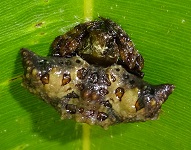| Home | Nature Weekly Index |
1 June 2014 | Bird Poo Spiders |
If after reading the title above on this post, you are still not convince that the bird poo pictures are actually spiders, you can google the terms and check it out yourself. Nature is fascinating if you know where to look.




Due to a last-minute emergency on last Saturday morning, I ended at Admiralty Park, which has been my backup destination if I cannot make it out far. Though I have been visiting the place for about 8 years now starting in 2008, it always gives me surprises on my return trips partly because I know where to look. Unfortunately, the park is not doing well compared to my first visit years back. Many tall trees had fell over time due to various reasons. The surrounding commercial and residential development continue to put pressure on the already shrinking park. I doubt the natural residents over there are please over the continue encroachment of the human species over a territory where they are supposed to have a fair share. I do share their sentiment.
Coming back to the bird poo spiders which I spotted at Admiralty Park, the other common terms used are bird dung and bird dropping. It is a way that nature provide a way for these little creatures to protect themselves by building the blueprint into their gene so that they present themselves like bird droppings. It does not look as glamorous as other creatures such as the butterflies but at least, it should give them a better chance of survival by deceiving their predators.
I spotted 3 of them on a young Bintangor Bunut tree (Calophyllum soulattri) and one on the neighbouring Limau Hantu shrub (Suregada multiflora). Though the 3 Pasilobus spiders, the sickle-shaped ones, looked slightly different, I think they are the same species. It may be just a variation in the body patterns among the same type of spider. Pasilobus spider has been reported to emit light under ultraviolet illumination.
The lone diamond-shaped spider is probably a Cyrtarachne species. It looked different from Cyrtarachne bufo, which has a whitish surface on top. It is unlikely to be the juvenile form of Cyrtarachne bufo since there was an egg sac nearby that I assumed belong to the spider. Another bird poo spider is Phrynarachne ceylonica, which come under the crab spider family (Thomisidae).